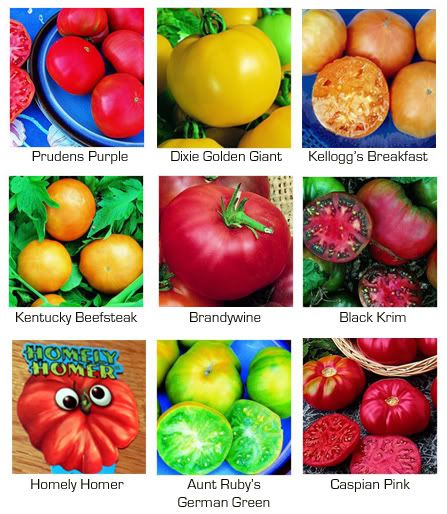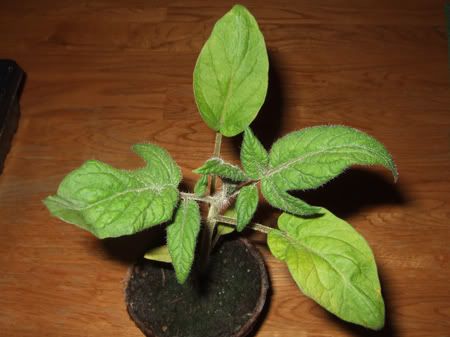The Pros and Cons of Heirloom Tomatoes
This year I have decided to grow a number of open-pollinated Heirloom tomatoes.

These are my 2007 selections. The photos came from Totally Tomatoes with the exception of the Homely Homer photo, which may or may not even be an heirloom. Totally Tomatoes is where I bought most of this years seeds.
I am a tomato fanatic. I love the taste of tomatoes! To me, organic garden vine-ripened fresh tomatoes are like candy is to a child. Not just any candy either. Tomatoes are like special Christmas candy that you can only get one time a year. When most people think of tomatoes, they think of plain red tomatoes. Possibly a beefsteak type. Today's "normal" tomatoes are hybrids that have been bred for disease resistance and good looks. I like the "normal" hybrid garden tomato very much. Let's think of it as the Christmas candy cane - special but common and abundant.
I don't know about you, but at Christmas when I was a kid I wanted more than just candy canes. There were always many other "special" candies like creme drops, ribbon candy, chocolate Santas, orange slices and more. By comparison, if you want "special" tomatoes, you need to grow heirloom varieties. There are so many different flavors and colors of heirloom tomatoes.
So what are the pros and con's of growing heirlooms?
Pros:
Cons:
The first pro is what I described above with the candy reference - superior and varied flavor! Last year I grew Brandywine, an Amish variety dating way back to the 1800's. Brandywine was by far the best tasting tomato I'd ever eaten! That's why I'm trying so many heirloom varieties this year. I'm growing another Amish variety, Dixie Golden Giant from the 1930's that is said to have "delicious, fruity flavor with few seeds." I also chose Caspian Pink, originally grown in Russia in the area between the Caspian and Black Seas. According to Totally Tomatoes, it was the only tomato that BEAT Brandywine in taste tests!
The 2nd reason to grow heirloom tomatoes is because some of them are very interesting! Look at the pictures of Aunt Ruby's German Green tomatoes, Kellogg's Breakfast, and Black Krim. Aunt Ruby's German Green is described as an "Heirloom green beefsteak with a deliciously sweet flavor that's enhanced by a spicy undertone." Okay, that's different. Totally tomatoes calls Black Krim "A most unusual novelty that is sweet and tasty".
The uniqueness doesn't stop at the tomato fruits either. Some heirlooms like Brandywine and Pruden's Purple have old-fashioned leaves that look more like potato leaves and tomato leaves. Here is one of my Pruden's Purple seedlings:

The third "Pro" is that it is fun to look up the origins of each heirloom variety. Each one has a special heritage of its own. There are varieties available from many different time periods and from all over the world. You may even be able to find a variety that is hundreds of years old from your home town! I am growing Kentucky Beefsteaks which are enormous orange beefsteaks that began right here in my home state.
Okay, enough of the "fun" talk of how great heirloom tomatoes are. Let's get into the "cons " or drawbacks of growing heirloom tomatoes.
First of all, true "heirlooms" are more than fifty years old and are still true to their parent plants. That means they have not been altered in any way like hybrids have. So the same thing that makes heirlooms great also make them very susceptible to disease and pests. Hybrid varieties many times have a series of letters after their names, like VFNT. This means the plants are resistant to verticillium and fusarium wilt, nematodes, and tobacco mosaic virus. Many heirlooms can be wiped out by these diseases. Hybrids are not necessarily bred to be resistant to insect or animal pests but it has been my experience that garden pests prefer the heirlooms (that's no surprise). My Brandywines last year were heavily attacked by Blister Beetles, Tomato Hornworms, and all of the low fruits were eaten by turtles.
The third drawback with heirloom tomatoes is that many of them don't produce as much fruit as a hybrid tomato plant. Mel Bartholomew of Square Foot Gardening" is always saying, "you only need to grow one tomato plant per person in your family". With heirlooms, I don't agree. When growing heirlooms, you should grow several plants as insurance against pests, disease and low yield. This is also why I am still growing 12 kinds of hybrid tomatoes.
So it comes down to exceptional flavor, being unusual and interesting with a sense of heritage versus being susceptible to disease and pests with possible lower yields. Do the pros outweigh the con's? For me they do. Bring on that yummy "candy-like" flavor! Bring on the strange and interesting qualities. Bring on the rainbow of colors!
And bring on the pests. I'm ready for a good old-fashioned battle of good versus evil. Heirloom tomatoes are worth fighting for. Wish me luck!














20 comments:
Is there an "official" definition of an heirloom? You mention that they've been around 50 years and haven't been crossed. Where does that definition come from? Is there a book that gives a decent explanation of what heirlooms are, how heirloom culture got started etc?
Arthur Allen, freelance writer, Washington, DC, beginning work on a history of the tomato
Heirloom can be a loose term. To me the definition is a known open pollinated variety that has not been crossed. The reason that I said 50 years is because hybrids began being created by growers around 1960 so true heirlooms would have to be from before that date.
Many people use the term heirloom to mean anything that is open-pollinated where the daughter plants will grow true to the parent.
A lot of growers do "create" new heirlooms. These new "heirloom varieties" are interseting too, but I try to find the varieties known to have been in existance for many many years.
Garden Desk is becoming the Wikipedia of Tomatoes. Another great tomato post.
Black Krim are delicious but I think I only got about 5 tomatoes from my plant last year. Very low production. I'm growing them again but I'm trying some different things like even more compost & manure and I'm going to use a foliar spray made from seaweed.
Maybe I'll get six this year. :)
Anthony - I'm glad to see that Black Krim is worth growing again a second year. The fact that you had a low yeild validates the third "con" on my list.
Let us know how your Black Krims do this year. I think you already know that I will be writing about how my heirlooms do.
The only one of these I've grown is, of course, Brandywine. Can't wait to read the results!
Good luck! I've grown Caspian Pink for a couple years and love it! I like the pink tomatoes! I don't remember it having a low yield, but maybe I just don't know any better! I got seeds from TT this year, too! Either Black Krim or Pruden's Purple reseeded for several years, too...(but I still like the pinks best...and big beefsteak tomatoes...and Sungold cherry tomatoes...you know how it is!)
low yields is an understatement. last year was the first year i grew brandywines, and i got TWO tomatoes from the plant. TWO. they were, however, ridiculously tasty, and they made very special sandwiches, let me tell you. i'm thinking i'll probably grow them again this year, but i haven't made up my mind.
oh, who am i kidding, that's a yes.
Great post. :) I only got one 'Black Krim' the year I planted them (which was admittedly not a great year for tomatoes) but it was absolutely delicious!
I have not had any serious problems with heirlooms and pests (ask me about squash however - cucumber beetles prefer pontimarron squash in my garden though they did fend them off).
Ethan and Blackswamp_girl - I hope you have better luck with getting more tomatoes this year if you try heirlooms again (and I think you should!)
Ottawa Gardener - I hope you have
success again with your tomatoes. Good luck fighting those cucumber beetles!
Gotta Garden - I am a beginner with heirloom tomatoes. You sound like the experienced expert! I am looking forward to the Caspian Pinks. Thanks for the update on you Eva's Purple Ball tomato plant. I'm glad it's doing better. Keep us posted on it's progress.
Heirlooms are not necessarily prone to disease, insects, or low production. If they were, they wouldn't have lasted the 50, 100, or more years they have been in existence. Hybrids are bred from heirlooms (or at least open-pollinated plants.) and that's where they get their disease-resistance, etc. from.
On the other hand, most hybrids are developed first and foremost to be easy to grow, and good for shipping. Somewhere in those efforts, the variations in rich or subtle flavors are often lost.
The point is, If you only get one tomato off your heirloom tomato plant, you're doing something wrong.
You are right that heirlooms are not "prone" to disease, but they are not resistant either. Unfortunately many diseases and insect pests are more prevalent now than they were 100 years ago. This of course is not the tomato plants fault. It is sometimes society's fault and sometimes the individual gardener's fault.
If you only get one tomato off of your heirloom plant then yes, SOMETHING is wrong but it may be out of the gardener's control.
So far this season, something is wrong with some of my heirlooms but my Black Krims are doing great! I've picked 8 beauties so far.
Thanks for the comment.
I just came across this thread now.
Just to add to why it may seem heirloom tomatoes have lower yields and seem more prone to disease and pest probably has more to do with neglect of the varieties than anything else.
Every variety has to be periodically grown out and selected. This is normally with at least several hundred plants over a few years, and someone who knows what they are doing have to rogue out the weaker plants and save seeds from the stronger ones.
Many heirloom varieties are in a very poor state because no one has been doing this with them. There are a few home gardeners around trying to do this, and the Seed Savers Exchange has started doing this too.
If there are particular varieties you are interested in putting some work into, you might try growing even 10-20 of them and only saving seeds from the best two or three plants. If you are able to do this a few years in a row, you will probably end up with dramatically improved seeds particularly well suited to your garden.
Maybe if heirloom varieties become more popular seed companies will decide it's worth paying attention to them again like they do now with the commercial varieties.
Marc,
Thanks for your post. I'll have to try Brandywine! Also, how do you keep the pests from eating them before you do?
Heirloom Gardener
Patrick brings up an excellent point about the quality of the parent plant that the seed came from. I am now being more choosy about where I buy my seed.
Thanks for coming by Heirloom Gardener! Keeping pests away is a problem. The best thing to do is keep the plants off the ground with good stakes or cages. I usually loose all of the lowest fruit to ground hogs and turtles. Some would disagree with me, but I have personally observed that animal pests and insects do indeed prefer the heirlooms. I figure that they must know something so this year I am growing 20 different heirloom tomatoes and 13 more hybrid varieties; 33 in all! With all those tomatoes, I guess I can afford to lose some the the hungry critters.
This is my first year growing heirloom tomatoes got lots of blooms but know fruit. does the fruit set later in the year? Does it get to hot in the desert southwest to grow heirlooms? Any tips or advice would be appreciated.
I am crazy about heirloom tomatoes and grow anywhere from 150 to 300 plants every year. And every year we have a new favorite. What turns out to be the very best one year will be surpassed by another variety the next. I think that each year the growing conditions are different, and better for some varieties than others. I am very fond of the "black" tomatoes. In 2003, our Black Brandywines were out of this world; in 2006, Cherokee Purple was the hands down winner. We have an old German pink tomato we call "Duke Shipp" that has been kept alive through my husband's Brady family since the 1930's and that is always wonderful every year.
Tomatoes are so special. You can buy almost anything year round these days, but there is only a small window of time -the only time - in which to enjoy a tomato at its best.
lebanonfan@yahoo.com
I have 3 Brandywine plants, this is my 3rd year even growing tomato plants, but I am growing more each year. Anyway, I was getting several blooms, but no tomato's. I decided to try some bloom spray from Lowe's and about 3-4 days later, I had some tomato's coming on. Maybe it was coincedence, but I don't think so. I put a little on in the evening every 7-10 days. I had my first Brandywine tomato yesterday 7/23/2008 and it was very sweet and like eating candy. Between the 3 plants, I count about 27 tomato's growing now. Mine are "skinny" plants, but one is about 8' tall.
So much time and effort go into our heirloom plants, I just wanted to mention the bloom spray and say that I think it is well worth the < $5 I paid for it. -Mike
This is a great post - thank you for that :) I just decided to grow heirlooms tomato next year :)
I learned a lot from this post.
Greetings,
Ewa
A friend and I are having a gentleman's disagreement about the difference between heirloom and hybrid tomatoes. He feels that heirloom tomatoes are merely a marketing device used by organic farmers to earn a premium for produce that is otherwise identical in taste to hybrid tomatoes. I take the oppposite view that heirlooms are superior in taste (ironically, I am a marketer, he is an attorney). I would like to assemble some facts to present to my friend to once and for all close the door on our ongoing tomato dispute. Can the readers of this blog give me a hand?
What are the objective arguments to be made to the tomato cynic?
Post a Comment